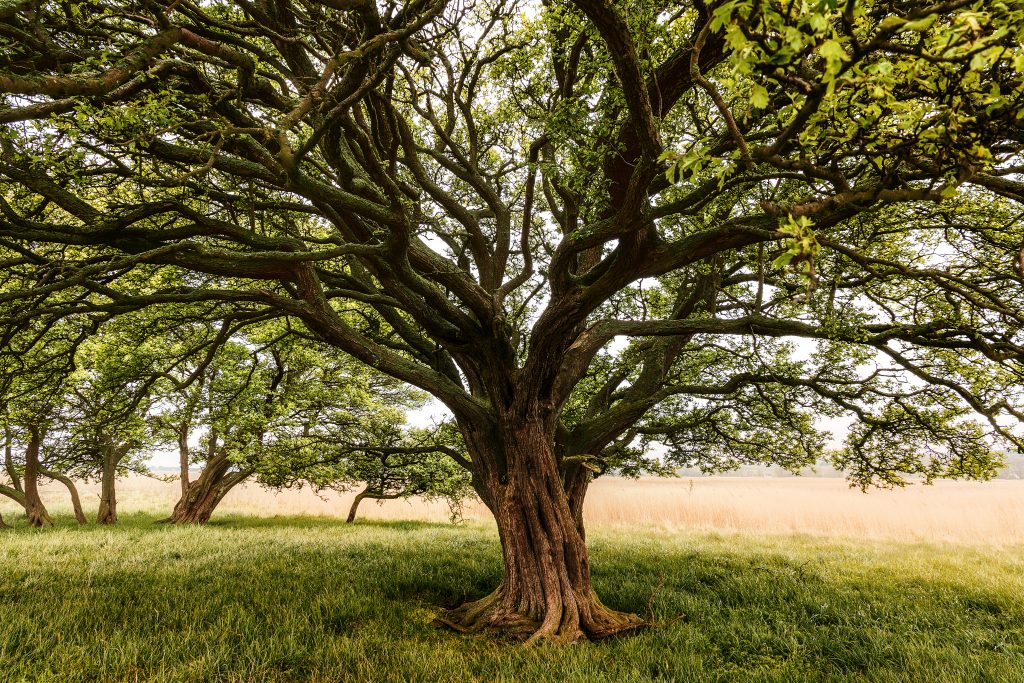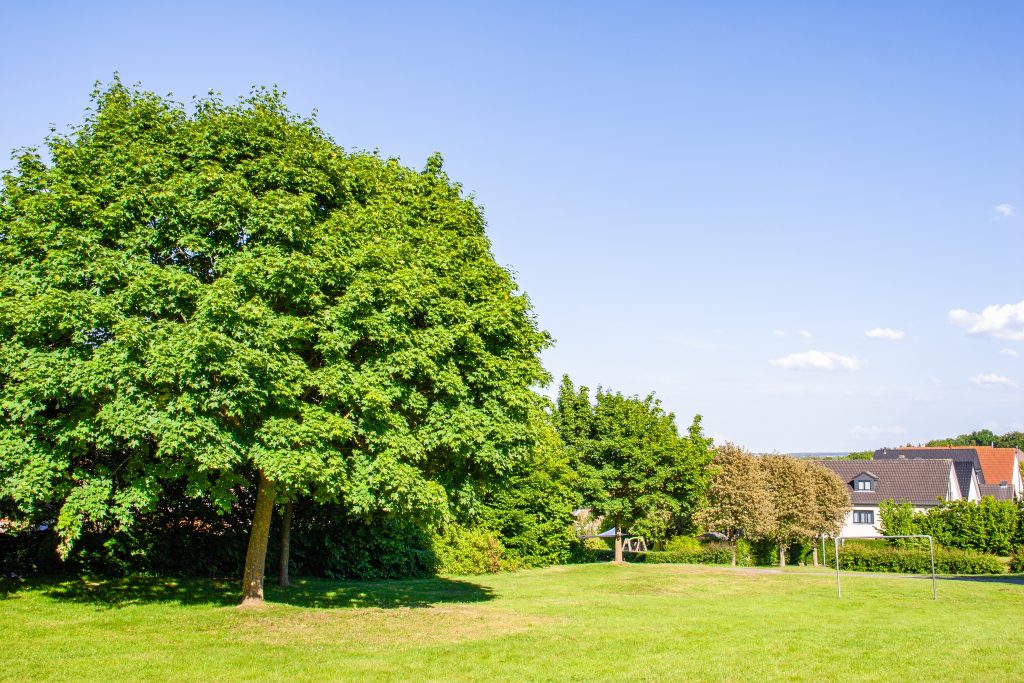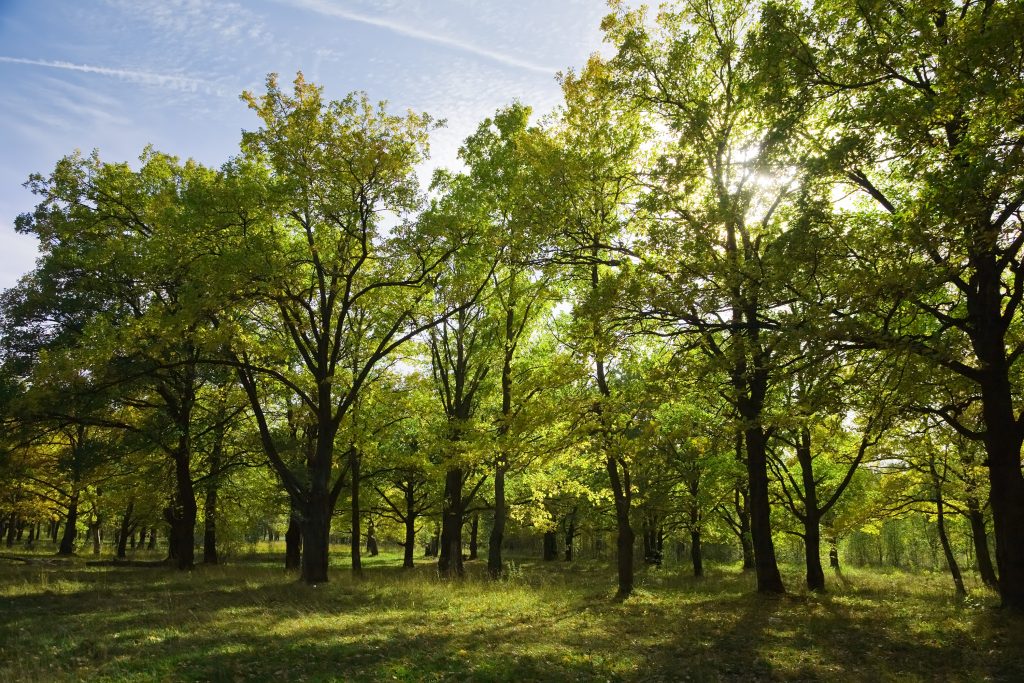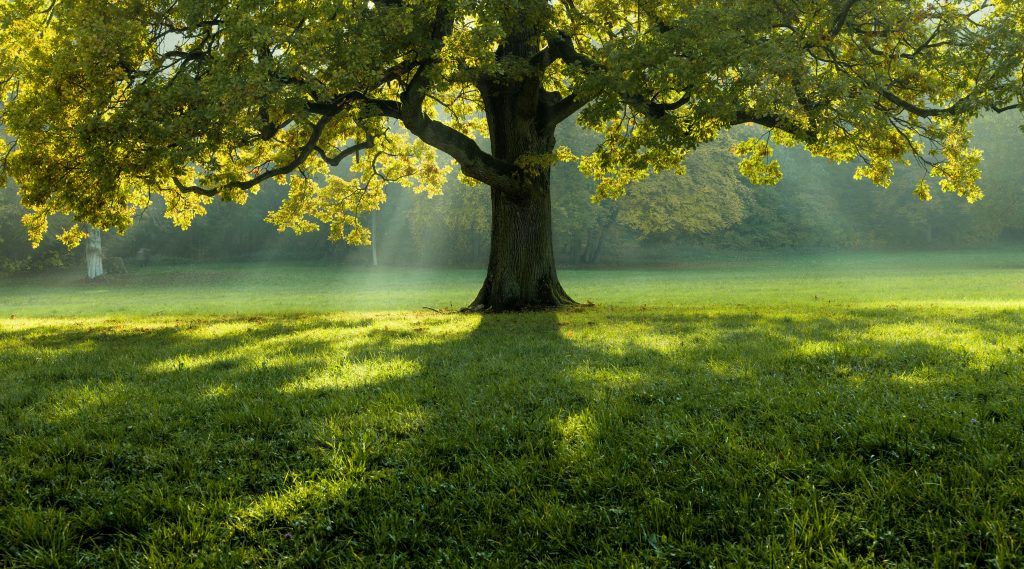THE BENEFITS OF USING TREES FOR SHADE AND COOLING
Trees play a vital role in providing shade and cooling solutions, particularly in urban environments where heat islands and rising temperatures pose significant challenges. The natural cooling and shading properties of trees make them essential components of sustainable urban planning and climate adaptation strategies. Here’s how trees contribute to shade and cooling:

- Natural Shade:
- Trees offer a natural and effective form of shade through their canopy of leaves. This shade reduces direct exposure to sunlight and helps create cooler outdoor spaces.
- Shaded areas underneath trees provide relief from intense sunlight, making outdoor activities more comfortable and enjoyable.
- Cooling Effect through Evapotranspiration:
- Trees release water vapor through a process called evapotranspiration, which has a cooling effect on the surrounding air.
- As trees transpire water from their leaves, it evaporates into the atmosphere, cooling the air temperature around the tree.
- Mitigating Urban Heat Island Effect:
- Urban heat islands occur when built environments absorb and retain heat, causing higher temperatures compared to surrounding rural areas.
- Trees mitigate this effect by shading surfaces, reflecting less sunlight, and releasing moisture, collectively reducing temperatures and making urban areas more comfortable.
- Energy Efficiency and Cost Savings:
- Trees strategically placed around buildings provide natural shading, reducing solar heat gain and cooling demand indoors.
- Reduced reliance on air conditioning leads to lower energy consumption, lower utility bills, and a decreased environmental footprint.
- Human Comfort:
- Trees create cooler microclimates that offer respite from heat, making outdoor spaces more inviting for relaxation, exercise, and socializing.
- Shaded areas encourage people to spend time outdoors, improving overall well-being and mental health.
- Air Quality Enhancement:
- Trees act as natural air purifiers by filtering pollutants and particulates from the air.
- Cleaner air quality benefits public health by reducing respiratory issues and improving overall environmental conditions.
- Biodiversity and Ecosystem Benefits:
- Trees provide habitat and food sources for birds, insects, and other wildlife, contributing to urban biodiversity.
- A diverse ecosystem is more resilient and adaptable to environmental changes.
- Carbon Sequestration:
- Trees capture and store carbon dioxide from the atmosphere through photosynthesis.
- Carbon sequestration helps mitigate climate change by reducing greenhouse gas concentrations.
- Community Engagement and Social Cohesion:
- Shaded public spaces under trees foster community interactions, gatherings, and recreational activities.
- These spaces strengthen social ties, promote inclusivity, and create a sense of place.
- Long-Term Investment:
- Planting trees is a long-term investment that provides ongoing benefits for generations to come.
- Trees become more valuable as they mature, contributing to climate resilience and adaptation.
In conclusion, trees’ natural shade and cooling properties make them invaluable assets for creating livable and sustainable urban environments. Their ability to mitigate heat, enhance air quality, promote human well-being, and support ecological diversity underscores their role in addressing climate challenges and building resilient communities.
Importance of Addressing Urban Heat and Climate Challenges
Addressing urban heat and climate challenges is of paramount importance due to their profound impact on both the environment and human well-being. As cities continue to grow and urbanization intensifies, these challenges become even more pressing. Here’s why addressing urban heat and climate challenges is crucial:

- Human Health and Well-Being:
- High temperatures can lead to heat-related illnesses and even fatalities, particularly among vulnerable populations like the elderly, children, and individuals with pre-existing health conditions.
- Excessive heat can exacerbate respiratory problems and cardiovascular diseases.
- Cooling measures can improve public health outcomes and enhance overall quality of life.
- Air Quality and Pollution:
- Urban heat can exacerbate air pollution by enhancing the formation of ground-level ozone, which poses serious health risks.
- Poor air quality linked to high temperatures can lead to respiratory issues and other health problems.
- Energy Consumption and Demand:
- Elevated temperatures increase the demand for cooling energy, straining electricity grids and leading to peak energy consumption.
- Increased energy use contributes to greenhouse gas emissions and air pollution.
- Urban Heat Island Effect:
- Urban areas are hotter than their rural surroundings due to human activities, infrastructure, and reduced vegetation.
- The urban heat island effect can intensify heatwaves and lead to temperature disparities across a city.
- Infrastructure and Property Damage:
- High temperatures can cause thermal expansion in materials like asphalt and concrete, leading to cracks and damage to roads and buildings.
- Heat stress can accelerate the deterioration of infrastructure, increasing maintenance costs.
- Water Demand and Scarcity:
- Elevated temperatures raise water demand for irrigation and cooling, straining water resources and potentially leading to water scarcity.
- Reduced water availability affects ecosystems and agricultural productivity.
- Economic Impact:
- Heat-related health issues, infrastructure damage, and energy demands can lead to economic losses for cities and businesses.
- Lost productivity due to heat stress can impact workforce efficiency.
- Biodiversity and Ecosystems:
- Urban heat can disrupt ecosystems, alter animal behavior, and impact plant growth.
- Loss of green spaces and habitats can reduce biodiversity and ecological balance.
- Climate Resilience and Adaptation:
- Adapting to climate challenges improves cities’ resilience to extreme weather events and changing climate patterns.
- Implementing cooling strategies contributes to long-term climate adaptation.
- Global Climate Impact:
- Urban heat contributes to the broader global climate change issue, as cities are significant contributors to greenhouse gas emissions.
- Addressing local heat challenges contributes to global efforts to mitigate climate change.
In summary, addressing urban heat and climate challenges is crucial for safeguarding public health, enhancing urban resilience, reducing energy consumption, and mitigating the impact of climate change. By implementing strategies that focus on creating cooler and more sustainable urban environments, cities can improve the well-being of their residents and contribute to a more sustainable and livable future.
Role of Trees in Providing Shade and Cooling Solutions
Trees play a multifaceted and indispensable role in providing effective shade and cooling solutions, making them invaluable assets in mitigating urban heat and enhancing the comfort and sustainability of urban environments. Here’s how trees contribute to shade and cooling:

- Natural Shade Creation:
- Trees create broad canopies of leaves that offer natural shade, reducing direct exposure to sunlight and heat.
- Shaded areas provide cooler spots for outdoor activities, gatherings, and relaxation.
- Temperature Reduction:
- Trees provide a cooling effect by shading surfaces and reducing the amount of solar energy absorbed by buildings, roads, and pavements.
- The shade created by trees can lead to temperature reductions in the shaded areas by several degrees.
- Evapotranspiration:
- Trees release water vapor through their leaves in a process called evapotranspiration.
- This cooling effect mimics the cooling sensation experienced when perspiration evaporates from the human body.
- Microclimate Creation:
- Trees contribute to the creation of microclimates in urban areas, where temperatures are moderated and more comfortable.
- Cooler microclimates under trees provide relief from the heat and encourage outdoor activities.
- Building Energy Efficiency:
- Trees strategically planted around buildings can shade walls, roofs, and windows, reducing solar heat gain.
- Reduced heat absorption by buildings leads to decreased indoor cooling demands and energy consumption.
- Air Cooling through Shade:
- Tree canopies provide shade for paved surfaces, reducing their heat absorption and minimizing heat reflection.
- Shaded pavements contribute to cooler sidewalks and streets.
- Cooling Effects in Parks and Green Spaces:
- Urban parks and green spaces with tree cover create cool oases where people can escape the heat.
- Such spaces encourage physical activity, social interactions, and a greater connection to nature.
- Air Quality Improvement:
- Trees filter pollutants from the air, enhancing air quality and reducing the heat-island-related formation of ground-level ozone.
- Climate Resilience:
- Trees contribute to the climate resilience of urban areas by countering the urban heat island effect and reducing the risk of heat-related illnesses.
- Carbon Sequestration:
- Trees absorb carbon dioxide from the atmosphere during photosynthesis, helping to mitigate climate change.
- Carbon sequestration contributes to the cooling of the planet by reducing greenhouse gas concentrations.
- Enhanced Aesthetics and Livability:
- Trees enhance the visual appeal of urban landscapes and streetscapes.
- Aesthetic greenery and shaded areas create pleasant environments that promote well-being.
- Biodiversity Support:
- Trees provide habitats for birds, insects, and other wildlife, fostering urban biodiversity and ecological balance.
In summary, trees are nature’s cooling systems, offering a range of benefits that extend beyond mere temperature reduction. Their ability to provide shade, create cooler microclimates, enhance energy efficiency, improve air quality, and contribute to biodiversity makes them indispensable assets in the quest for cooler, more sustainable, and livable urban environments.
How Trees Provide Natural Shade Through Their Canopy
Trees provide natural shade through their canopy, which is the collection of leaves, branches, and stems that create a layer of coverage above the ground. This canopy acts as a natural sunshield, reducing the amount of direct sunlight that reaches the ground beneath the tree. Here’s how trees offer natural shade through their canopy:

- Leaf Arrangement and Structure:
- The arrangement of leaves on branches creates a dense and layered canopy structure.
- Leaves are positioned in a way that they overlap and interlock, forming a barrier that intercepts and filters sunlight.
- Leaf Surface Area:
- The large surface area of leaves enables them to capture sunlight for photosynthesis while also blocking a significant portion of sunlight from reaching the ground.
- Light Absorption and Reflection:
- Leaves absorb and reflect sunlight. The chlorophyll within leaves absorbs sunlight to facilitate photosynthesis, and some sunlight is reflected off the leaf surfaces.
- Shade Casting:
- As sunlight passes through the canopy, it is filtered and diffused, creating varying levels of shade underneath the tree.
- The density of the canopy and the angle of the sun determine the intensity of shade cast on the ground.
- Seasonal Variations:
- The density of the canopy may change throughout the year as leaves grow, change color, and eventually fall during different seasons.
- Deciduous trees, for example, provide shade during the growing season but allow more sunlight to pass through during winter when they lose their leaves.
- Microclimates:
- Canopies create microclimates under trees that are cooler and more comfortable than exposed areas.
- This shaded environment results from a combination of reduced sunlight, cooler air temperature due to evapotranspiration, and the filtering effect of the canopy.
- Outdoor Comfort:
- The shade provided by tree canopies makes outdoor spaces more inviting and suitable for various activities, such as picnics, reading, or simply relaxing.
- Energy Savings:
- When tree canopies shade buildings, they reduce solar heat gain through roofs, windows, and walls.
- Reduced solar heat absorption translates to lower indoor temperatures and decreased energy consumption for cooling.
- Protection from UV Radiation:
- Tree canopies also help protect individuals from harmful ultraviolet (UV) radiation from the sun.
- While not as effective as sunscreen, the shade provided by trees offers an additional layer of protection.
In essence, the natural shade provided by trees’ canopies is a valuable ecological service that enhances outdoor comfort, reduces energy use, and contributes to the overall well-being of both humans and the environment. Trees’ ability to create cooler, shaded environments underscores their significance in addressing urban heat challenges and promoting sustainable urban living.


Comments are closed.